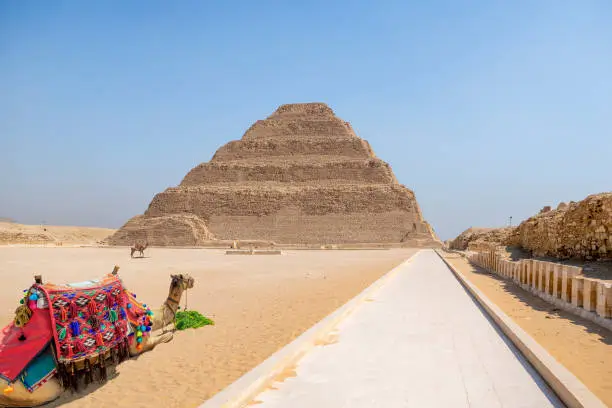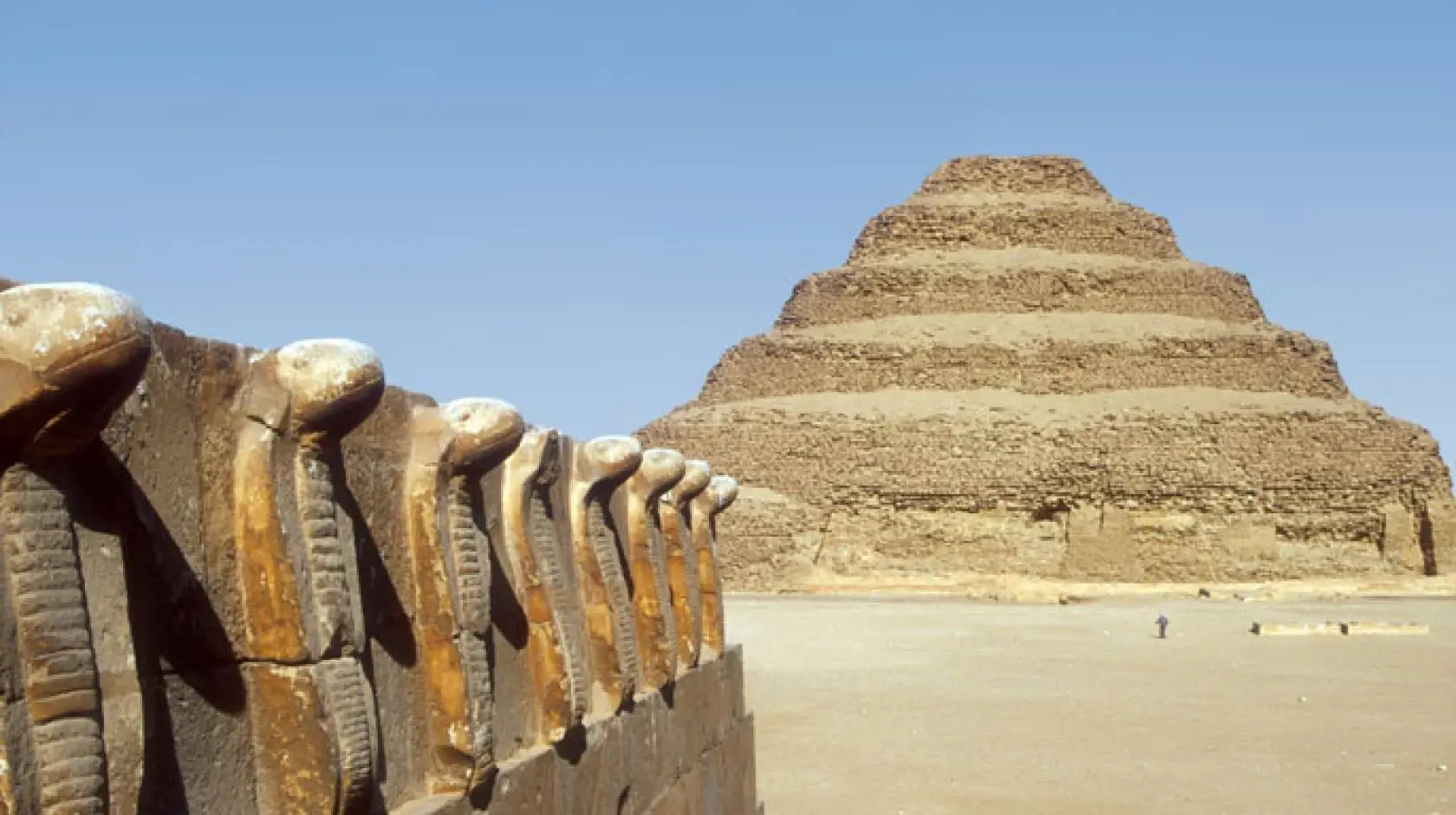Sakkara Egypt

Sakkara Egypt
Sakkara—sometimes spelled Saqqara—is not just another dusty ruin in the Egyptian desert. It’s a timeless monument of innovation, grandeur, and spiritual significance. Nestled just south of Cairo, Sakkara served as the necropolis for the ancient city of Memphis, the first capital of unified Egypt. But more than that, it gave birth to the very concept of the pyramid, the stepping stone—literally—to the wonders of Giza and beyond.
Though the Pyramids of Giza might steal the spotlight, Sakkara whispers deeper secrets. It’s home to Egypt’s oldest pyramid—the Step Pyramid of Djoser—and hundreds of tombs, corridors, temples, and hidden burial shafts that continue to astonish archaeologists to this day.
So, why does Sakkara still matter in the 21st century? Because it’s where the story of monumental Egyptian architecture, organized burial rites, and spiritual transformation begins.
Geographical Setting of Sakkara

Sakkara Egypt
Sakkara is situated roughly 30 kilometers (19 miles) south of Cairo, on the west bank of the Nile. It stretches over 7 kilometers of desert, dotted with crumbling mastabas, hidden tombs, and pyramids in various states of ruin. But make no mistake—this desolate place was once bustling with life and reverence.
Its location was not random. Ancient Egyptians believed that the west was where the sun died every night—symbolizing death. That’s why nearly all necropolises, including Sakkara, were built on the west bank of the Nile.
This area formed a critical part of Memphis, Egypt’s ancient capital during the Old Kingdom. As such, Sakkara wasn’t just a cemetery—it was a sacred hub for funerary traditions and religious experimentation.
Origins of Sakkara
Long before towering pyramids touched the skies of Egypt, the land of Sakkara was already sacred. Evidence suggests that burials took place here as early as the 1st Dynasty (c. 3100–2890 BCE). At first, tombs were simple mastabas—flat-roofed structures with rectangular shapes, used to bury elite officials.
But the game changed forever during the reign of Pharaoh Djoser in the 3rd Dynasty. His innovative step pyramid, designed by the polymath Imhotep, set the blueprint for centuries of pyramid-building.
Sakkara transformed into a living laboratory of funerary evolution, blending architecture, theology, and art.
Step Pyramid of Djoser
The Step Pyramid isn’t just a pile of stacked stones—it’s a radical invention. It was the first large-scale stone structure in history. Built around 2670 BCE, it broke away from the traditional mastaba design by stacking six terraces on top of each other.
Imhotep, Djoser’s chancellor and high priest, envisioned a structure that would carry the pharaoh’s soul to the heavens—layer by layer. This pyramid stood 62 meters tall (about 203 feet) and was originally clad in smooth limestone, gleaming under the Egyptian sun.
It’s surrounded by a massive complex featuring temples, chapels, and ceremonial courts, including the Great South Court and the Heb Sed Court, used to symbolically rejuvenate the king’s rule. Even today, walking through its colonnaded corridors evokes awe and reverence.
Imhotep: Architect and Genius
Imhotep was no ordinary architect. He was a mathematician, astronomer, physician, priest, and philosopher—a true Renaissance man millennia before the Renaissance. He was later deified by Egyptians and even worshipped by the Greeks as the god of medicine.
By designing the Step Pyramid, Imhotep not only revolutionized Egyptian architecture but also created a prototype for divine kingship. He proved that architecture could be theology in stone.
His influence radiated throughout Egyptian history and left its mark on everything from temple design to tomb iconography.
Old Kingdom Burials
Sakkara continued to flourish during the Old Kingdom. Pharaohs like Unas, Teti, and Pepi I chose this sacred site for their final resting places. Their pyramids, although smaller and less preserved, hold massive historical value.
Il Pyramid Texts inscribed inside the Pyramid of Unas are the oldest religious texts known to man. These spells were meant to guide the deceased through the underworld—a precursor to the more elaborate Book of the Dead used in later dynasties.
Unlike the grandeur of the Step Pyramid, these later pyramids emphasized spiritual guidance over architectural scale, marking a shift in Egyptian religious philosophy.
Middle Kingdom Activity
After the fall of the Old Kingdom, Egypt went through a turbulent phase of decentralization. Sakkara saw reduced activity during the Middle Kingdom (c. 2050–1710 BCE), as regional cemeteries gained prominence.
Still, a handful of tombs and chapels were built here, often reusing older structures. This period saw an increase in private tombs, indicating a rising middle class eager to mimic the elite burial traditions.
Though no major pyramids were constructed during this era in Sakkara, its spiritual status remained intact, waiting for revival.
New Kingdom Revival
The New Kingdom (c. 1550–1070 BCE) brought Sakkara roaring back to life. High officials, generals, and priests built elaborate tombs along its avenues. The tomb of Horemheb, before he became pharaoh, showcases incredible wall carvings and autobiographical inscriptions.
Temples were rebuilt, and burial rituals revived. Sakkara had become a nexus where tradition met innovation, and ancient beliefs merged with Theban religious influences.







Impressionante https://is.gd/tpjNyL
Buona https://is.gd/tpjNyL
Buona https://is.gd/N1ikS2
Buona https://is.gd/N1ikS2
Molto buona https://is.gd/N1ikS2
Ciao!
Investire nei mercati finanziari con la facilità con la nostra piattaforma di trading opzioni binarie. Scegliere da una vasta gamma di attività, tra cui azioni, commodities e forex, e usare i nostri strumenti per formulare previsioni. Iniziare a guadagnare profitti di oggi con rendimenti fino al 85%.
Guadagnare ogni minuto senza limite di $100, $500, $1.000, con una puntata minima di 1$.
Immediato ritiro!!!
Codice Bonus: OLYMPOLYMP
Da $50 +30% di deposito!
+ Conto Demo!
+ Segnali Gratis!
ATTENZIONE! Se si sta tentando di accedere al sito da i seguenti paesi, è necessario attivare il VPN che non si applica ai seguenti paesi!
Australia, Canada, USA, Giappone, regno UNITO, UE (per tutti i paesi), Israele, Russia, Iran, Iraq, Corea, Repubblica centrafricana, Congo, Costa d'Avorio, Eritrea, Etiopia, Libano, Liberia, Libia, Mali, Mauritius, Myanmar, Nuova Zelanda, Saint Vincent e Grenadine, Somalia, Sudan, Siria, Vanuatu, Yemen, Zimbabwe.
Iscriviti e inizia a guadagnare dal primo minuto!
https://trkmad.com/101773
Идеальные источники бесперебойного питания для дома, узнайте.
Рейтинг лучших ИБП, ознакомьтесь.
Обзор функций источников бесперебойного питания, узнайте.
Топ-5 ИБП для защиты техники, на нашем сайте.
Как выбрать идеальный источник бесперебойного питания, получите советы.
Советы по покупке источников бесперебойного питания, с нашими рекомендациями.
Источники бесперебойного питания: как выбрать лучший, обратите внимание.
Все о принципах работы источников бесперебойного питания, в нашем материале.
Советы по использованию ИБП, читайте.
Инновации в области источников бесперебойного питания, в нашем обзоре.
Как правильно подключить ИБП, в нашем гиде.
Идеальные источники бесперебойного питания для бизнеса, с нашим руководством.
Источники бесперебойного питания: советы и хитрости, узнайте.
Сравнение ИБП: какой выбрать?, читайте.
Советы по монтажу источников бесперебойного питания, читайте.
Идеальные решения для бесперебойного питания, ознакомьтесь.
Устранение неисправностей ИБП, получите советы.
Как выбрать ИБП для игры, читайте.
Топ-10 источников бесперебойного питания на рынке, в нашем блоге.
источники бесперебойного питания купить [url=https://istochniki-bespereboynogo-pitaniya.ru#источники-бесперебойного-питания-купить]https://istochniki-bespereboynogo-pitaniya.ru[/url] .